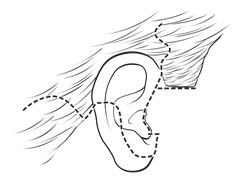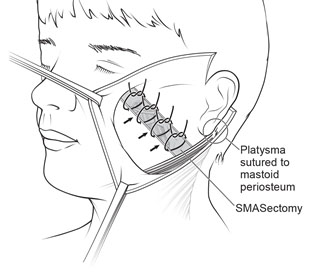A facelift usually takes three to four hours or somewhat longer if you’re having more than one procedure done.
Every surgeon approaches the procedure in his or her own way. The exact placement of incisions and the sequence of events depends on your facial structure and your surgeon’s technique but incisions usually begin above the hairline at the temples, extend in a natural line in front of the ear (or just inside the cartilage at the front of the ear), and continue behind the earlobe to the lower scalp. If the neck needs work, a small incision may also be made under the chin.
Every surgeon approaches the procedure in his or her own way. The exact placement of incisions and the sequence of events depends on your facial structure and your surgeon’s technique but incisions usually begin above the hairline at the temples, extend in a natural line in front of the ear (or just inside the cartilage at the front of the ear), and continue behind the earlobe to the lower scalp. If the neck needs work, a small incision may also be made under the chin.

Types of facelift incisions. All incisions are hidden and minimally visible after healing
In general, the surgeon separates the skin from the fat and muscle below. Fat may be trimmed or suctioned from around the neck and chin to improve the contour. The surgeon then tightens the underlying muscle and membrane (SMAS), pulls the skin back, and removes the excess. Stitches secure the layers of tissue and close the incisions; metal clips may be used on the scalp.

SMAS-ectomy: The most common facelift technique we use involves the removal of a strip of the SMAS (Subcutaneous Musculo-Aponeurotic System) and re-approximation of the edges in order to tighten and lift the deeper tissues. The neck muscle (platysma) is also anchored behind the ear in order to lift the neck and under-jaw areas.
Following surgery, a small, thin tube may be temporarily placed under the skin behind your ear to drain any blood that might collect there. The surgeon may also wrap your head loosely in bandages to minimize bruising and swelling.
The facelift procedure continues to evolve. Over the years, the procedure has changed from simple skin lifting tomore complex deeper plane lifting techniques. Today, many different techniques exist, with outcomes that are consistently reliable and durable. The modern trends in facelifting at the present time are best summarized as follows:
- Volume versus tension—Placing tension on the skin is an ineffective way of lifting the face and is responsible for the “facelifted” look and for unsightly scars and distortion of the facial landmarks such as the hairline and ear. The current trend is toward redistributing, or augmenting, facial volume, rather than flattening it with excessive tension.
- Less invasive—That the more “invasive” techniques have not yielded benefits in proportion to their risk combined with the public demand for rapid recovery has led to simplified procedures.
- Facial harmony—The goal is to help a patient look better, not weird or operated on. Excessive tension, radical defatting, exaggerated changes, and attention to one region while ignoring another may result in disharmony. The face is best analyzed and manipulated with the entire face (and the entire body) in mind, not the individual component parts, lest the “forest be lost for the trees.”
- Recognition of atrophy—The process of aging involves not only sagging of the tissues and deterioration of the skin itself but atrophy of tissues, especially fat, in certain areas. Most patients are best served with limited defatting and may require addition of fat to areas of atrophy.
The results are a reversal of the effects of gravity and tightening of soft tissues of the face to restore a more youthful contour to the face. Most commonly, the facelift procedure is combined with an eyelid lift (blepharoplasty), and frequently with fat transfer (autologous fat grafts).





